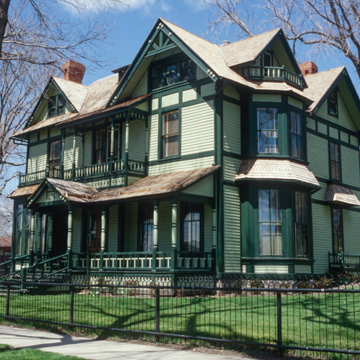In 1893, the state legislature allotted a meager six thousand dollars for the purchase or construction of a suitable residence for the governor. Mindful of the appropriation’s insufficiency to build a new residence, a house built by prosperous businessman Asa Fisher was purchased. The house served as the official residence of North Dakota governors until 1960, when a new executive mansion was constructed at the southwest corner of the state capitol grounds. The former governor’s residence is a two-and-a-half-story wooden house that shows Stick Style influence. Front and rear entrance porticoes open onto a large central hallway. Ground-floor spaces include front and rear parlors, dining room, pantry, and kitchen. An open staircase leads to three upper-floor bedrooms and a sewing room. Two smaller upstairs bedrooms and a separate bath are accessed from a rear stairway that serves the kitchen. An architecturally distinctive carriage house at the rear of the property was converted to living quarters for a caretaker. Since 1975, the house has been operated by the State Historical Society as a conference facility and historic house museum highlighting the restoration process.
You are here
Historic Governor’s Mansion
If SAH Archipedia has been useful to you, please consider supporting it.
SAH Archipedia tells the story of the United States through its buildings, landscapes, and cities. This freely available resource empowers the public with authoritative knowledge that deepens their understanding and appreciation of the built environment. But the Society of Architectural Historians, which created SAH Archipedia with University of Virginia Press, needs your support to maintain the high-caliber research, writing, photography, cartography, editing, design, and programming that make SAH Archipedia a trusted online resource available to all who value the history of place, heritage tourism, and learning.















